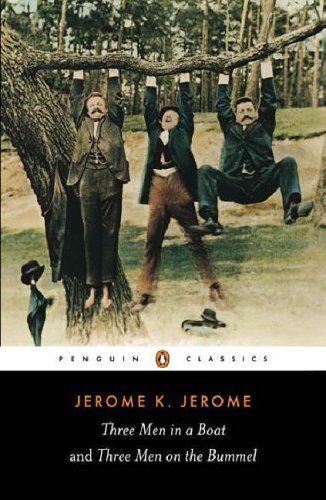Three Men in a Boat and Three Men on the Bummel
Read Three Men on Bummell if you enjoy irreverent commentary on human nature. This book is for cyclists, couch potatoes and just about anyone who enjoys humor.
by Nancy Kerstetter
Many readers are familiar with the farce Three Men in a Boat penned in 1889 by Jerome K. Jerome, but how many realize he wrote a follow up to that popular book? Three Men on the Bummel picks up the same three major characters to sketch their adventures on a nonsensical bicycle tour through Germany.
 Three Men on the Bummel is a perfect reading choice for those who have been to Europe, those who want to go to Europe and those preparing to leave immediately to visit those countries. Read this book if you enjoy irreverent commentary on human nature, or satire. This book is for cyclists, couch potatoes and just about anyone who enjoys humor.
Three Men on the Bummel is a perfect reading choice for those who have been to Europe, those who want to go to Europe and those preparing to leave immediately to visit those countries. Read this book if you enjoy irreverent commentary on human nature, or satire. This book is for cyclists, couch potatoes and just about anyone who enjoys humor.
The three men—J, George and Harris (J narrates their story)—concoct a ploy to escape from work and their families. George and Harris are tied down with wives, children and the varied obligations that accompany such responsibilities. As the only one unmarried, J is a free agent. Montmorency, the dog in Three Men in a Boat, does not make the trip to Germany.
Plot twists flavor the thoroughly enjoyable read. The first one is how the wives have their own agenda and do not obstruct the men’s planned trip. Jerome uses word plays, exaggerations, asides and digressions to unravel his witty tale. Like Three Men in a Boat, Three Men on the Bummel is a social satire. It’s reminiscent of Oscar Wilde’s subject matter. Wilde and Jerome are contemporaries. Both are brilliant word handlers.
Jerome hints at the lighthearted tone of his book on the third page when he states, “There will be no useful information in this book.” That statement is guaranteed to draw in every reader with a cock-eyed sense of humor.
The bulk of Three Men on the Bummel takes place in Germany. It has uncanny tones that foretell the coming political and social unrest of that country. Jerome digresses with an anecdote of throwing items out an inn’s window at yowling cats in the wee hours of the night and the ensuing nocturnal call a policeman makes. Humorously he comments, “The German policeman does not understand a joke, which is perhaps on the whole just as well, for I believe there is a heavy fine for joking with any German uniform…”
Later, a discourse on Germany’s long history of soldiering, following orders and military action hits a chord with modern readers. Jerome states, “The German can rule others, and be ruled by others, but he cannot rule himself. The cure would appear to be to train every German for an officer, and then put him under himself. It is certain he would order himself about with discretion and judgement, and see to it that he obeyed himself with smartness and precision.”
Regarding Germany’s education system, he writes, “Their everlasting teaching is duty. It is a fine ideal for any people; but before buckling to it, one would wish to have a clear understanding as to what his ‘duty’ is. The German idea of it would appear to be: ‘blind obedience to everything in buttons’…Hitherto, the German has had the blessed fortune to be exceptionally well governed; if this continues, it will go well with him. When his trouble will begin will be when by any chance something goes wrong with the governing machine.”
These prophetic observations are unsettling as we note this book was written in 1900 prior to the rise of German world domination desires.
Overall Three Men on the Bummel is an entertaining light read. It is not necessary to read Three Men in a Boat first. In fact, reading that one might deter you from the real gem of the bicycling tome. If you enjoyed the picaresque adventures of Miguel De Cervantes’ misguided, blundering hero Don Quixote, you will undoubtedly revel in the bumbling German bicycling journey. Both the boating story and Don Quixote are a bit long-winded for my taste. Then again, perhaps Don Quixote was so ponderous because I read it in the Spanish language.
You can obtain this book from your local library, interlibrary loan or from Amazon.